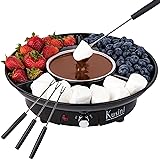HexClad Hybrid Nonstick 6-Piece Fry Pan Set, 8, 10, and 12-Inch Frying Pans with Tempered Glass Lids, Stay-Cool Handles, Dishwasher-Friendly, Induction Ready, Compatible with All Cooktops
20% OffNostalgia Tabletop Indoor Electric S'mores Maker - Smores Kit With Marshmallow Roasting Sticks and 4 Trays for Graham Crackers, Chocolate, and Marshmallows - Movie Night Supplies - Brown
$29.98 (as of December 6, 2025 13:00 GMT -05:00 - More infoProduct prices and availability are accurate as of the date/time indicated and are subject to change. Any price and availability information displayed on [relevant Amazon Site(s), as applicable] at the time of purchase will apply to the purchase of this product.)Kusini Electric Fondue Pot Set - Chocolate Fondue Kit - Temperature Control, Detachable Serving Trays, & 4 Roasting Forks - Gift Set & Date Night Idea. Serve at Movie Night or Game Night.
37% OffHealth Risks of Using Cheap Aluminum Pans
Understanding Aluminum Leaching
So, let’s dive into something I’ve learned the hard way: the health risks that come along with using those budget-friendly aluminum pans. You see, aluminum is not inert; it can leach into food, especially when cooking acidic dishes like tomatoes or citrus. I’ve noticed that after cooking, meals sometimes have a metallic taste, and that’s usually a sign that the aluminum got mixed up with my food.
Research shows that high levels of aluminum exposure can be linked to various health issues, including some neurodegenerative diseases. While the jury’s still out on the exact effects, it’s better to be safe than sorry. Cooking with cheap aluminum pans isn’t just a shortcut; it can come back to bite you in ways you didn’t expect.
When I switched to better quality cookware, I felt a weight lift. Knowing that my food wasn’t interacting with those nasty metals greatly improved my peace of mind. Making that change was worth every penny, and I can honestly say my health felt the boost!
Durability and Performance Concerns
The Longevity of Cheap Aluminum Cookware
Let’s chat about durability because that’s where cheap aluminum pans really fall short. They tend to warp and scratch easily, and I’ve experienced this firsthand. One minute they look good, but after a few uses, they start to show signs of wear that make me question their reliability.
When a pot or pan warps, it doesn’t heat evenly, which means your food might cook unevenly too. You’ll end up with hot spots or cold spots, and trust me, nothing is worse than serving a meal that is half-cooked and half-burnt. I found myself constantly checking whether my food was properly cooked, and that was just plain annoying.
Investing in higher-quality cookware means investing in something that will last. I still have pans from years ago that perform like new, and that’s what I call a win. As someone who loves to cook, I want tools that inspire confidence rather than anxiety!
Environmental Impact of Cheap Aluminum Production
The True Cost of Aluminum Production
Here’s something that might surprise you: cheap aluminum pans come with a hefty environmental price tag. The process of extracting aluminum is energy-intensive and contributes significantly to carbon emissions. This was an eye-opener for me because every time I bought those cheap pans, I unknowingly supported practices that harm the planet.
Moreover, not all aluminum is recycled effectively. A lot of it ends up in landfills where it can take centuries to decompose. I realized that every time I tossed a pan that was barely used, I was just adding to a growing pile of waste. It’s depressing when you think about it!
Now, I try to choose brands committed to sustainability, and I opt for cookware that lasts. Not only do I feel better about my purchases, but my kitchen eco-footprint shrinks a bit with every good choice. It feels nice knowing I’m making a difference, one pan at a time!
Safety Standards and Regulations
Understanding Labeling and Claims
When it comes to cookware, just because it’s on the shelf doesn’t mean it’s safe to cook with. Cheap aluminum pans might not meet rigorous safety standards, and that was a hard lesson for me to learn. Many budget products are made in countries with less stringent regulations, which raises concerns about quality.
I had a friend who bought some inexpensive pans online only to find out they were coated with non-stick substances that released harmful chemicals when heated. It was a real scare! This led me to invest a little more time into researching brands and understanding what labels to look for.
Being informed has transformed how I shop for cookware. I now check for certifications and read reviews from trusted sources. My kitchenware isn’t just about cooking; it’s about safety and standards. A little vigilance goes a long way!
Cost vs. Value: Making Smart Purchases
The Long-Term Financial Perspective
Let’s face it, we all love a good deal, but what an incredible bummer when cheap really turns out to be expensive! Cheap aluminum pans might save you some bucks at first, but when they warp, scratch, or leach, you find yourself spending more in the long run when you have to replace them constantly.
I used to think I was saving money, but I did the math one day and realized I had spent just as much—if not more—on replacements over the years than I would have spent on a high-quality pan that has lasted me for years. It’s wild to think about, and it’s a reality check I want to share.
Now, my motto is: invest wisely. Quality cookware not only performs better but can also bring joy back to cooking. Not having to replace pans every few months allows me to focus more on the meals I create rather than the tools I use. That’s what cooking is all about!
Frequently Asked Questions
What are the health risks associated with using cheap aluminum pans?
Cheap aluminum pans can leach aluminum into your food, especially when cooking acidic items. While casual use might not pose a significant risk, long-term exposure could be linked to various health issues.
How can cheap aluminum pans affect cooking performance?
They often warp and scratch easily, which can lead to uneven heating. This means your meals might not cook as well as they should, resulting in inconsistently prepared food.
Are there environmental concerns with aluminum production?
Absolutely! The extraction of aluminum has significant environmental impacts, including high energy consumption and substantial carbon emissions. Additionally, disposable pans contribute to landfill waste.
What should I look for when purchasing cookware?
Opt for brands that comply with safety standards, prioritize sustainability, and provide detailed information about their products. Reviews and certifications can guide you towards safer, more reliable options.
Is it worth it to invest in high-quality cookware?
Yes! High-quality cookware often performs better, lasts longer, and can save you money in the long run. Plus, it makes the cooking experience more enjoyable and provides peace of mind regarding safety.

















